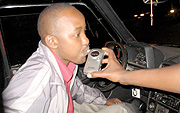Police officers at check points and accidents investigators are equipped with CA-2000 breathalyzers, commonly known as alcotests. They are designated by AlcoMate and manufactured in Korea. The battery-operated devices are slightly larger than a deck of cards and retail for about $90 (Frw49,000). In order to obtain an alcohol content reading, an individual must blow steadily into the mouthpiece for about five seconds.


Police officers at check points and accidents investigators are equipped with CA-2000 breathalyzers, commonly known as alcotests. They are designated by AlcoMate and manufactured in Korea. The battery-operated devices are slightly larger than a deck of cards and retail for about $90 (Frw49,000). In order to obtain an alcohol content reading, an individual must blow steadily into the mouthpiece for about five seconds.
The police put a new disposable plastic cover over the mouthpiece for each test to ensure the procedure is hygienic.
Within about five to 10 seconds, the digital monitor displays the individual’s likely blood alcohol content (BAC).
If it is above 0.08 grams of alcohol per 100 milliliters of blood, the person is considered to be legally drunk. If the device registers as "hot” and a red light appears, the individual’s estimated BAC is over 0.40 and is literally off the charts.
It is a common misconception that that breathalyzers measure BAC directly. A breathalyzer provides a reliable estimation of a person’s BAC. As blood flows through the body some of the alcohol in the bloodstream is transferred into air sacs in the lungs. The amount of alcohol that remains in the lungs and, subsequently in a person’s breath, is related the amount of alcohol in the bloodstream.
A breathalyzer analyzes the sample and converts the alcohol concentration in the breath to an estimated BAC. The only way to measure BAC directly is to draw and test an individual’s blood.
Breathalyzers are generally considered to be very reliable, but their readings can be affected by some factors. According to the CA-2000 instructional manual, if an individual has consumed alcohol up to 20 minutes before taking the test, the device might pick up some alcohol residue in the person’s mouth and provide a false positive.
Baguma said that officers are aware of the potential for false positives, but that it is not a major concern.
"Most of the checkpoints you see, they are not located near pubs under the assumption that [when people reach the checkpoints] those 20 minutes have elapsed,” he said. The checkpoint near Gishushu was only a few minutes away from one of Kigali’s more popular bars, Club Planet.
Breathalyzers cannot be affected by breath mints, coffee or spicy foods. These techniques may change the smell of the individual’s breath but not their BAC.
Ends




